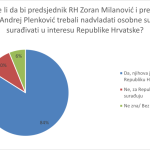As Poslovni Dnevnik/Jadranka Dozan writes, the registered Croatian unemployment rate dropped down to 7 percent back in September after a very tough period caused by the pandemic in 2020. Of 1.7 million economically active individuals who make up the Croatian population, there were 119,000 unemployed persons.
However, behind that average rate at the county level is a very wide range indeed. According to the latest CBS data, of the 97,000 economically active members of the population in Istria County in September, less than 3,000 were unemployed (2,926), bringing the Croatian unemployment rate in that particular part of the country down to just three percent.
Varazdin County also has 2,158 unemployed persons, which means an unemployment rate of 3.1 percent per 70.7 thousand of the economically active population. In contrast, in six counties, the Croatian unemployment rate is still in the double digits. In Virovitica-Podravina and Osijek-Baranja it stands at a rather unimpressive 13.3 percent. This is almost twice the Croatian average. Most other counties with unemployment above 10% are located continental Croatia: 12.3 percent in Sisak-Moslavina, 12 percent in Brod-Posavina, and 11 percent in Vukovar-Srijem.
Heading to the coast, Split-Dalmatia is also close, with 11.4 percent. In these counties, the average net salaries of employees in legal entities generally lag behind the overall Croatian average as well, which was 7,108 kuna back in September. Only the average salaries in the City of Zagreb (8,469 kuna) and Zagreb County (7,183 kuna) are higher than that, while in Virovitica-Podravina, for example, it was 6,082 kuna, almost 15 percent below the Croatian average.
Among the counties with the lowest average salaries are Vukovar-Srijem County (6,204 kuna), Bjelovar-Bilogora and Brod-Posavina (6,255 kuna and 6,266 kuna) and Pozega-Slavonia County (6,331 kuna).
In terms of nominal annual growth of the country’s average wages, the range by counties is also large.
For more, check out our dedicated business section.











